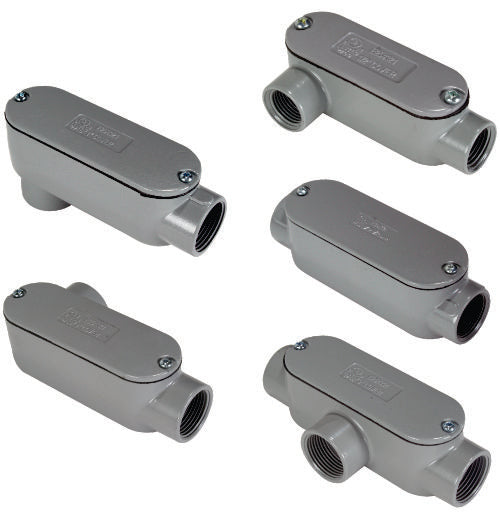When planning or installing an electrical conduit system, conduit bodies play a vital role in making bends, pulling wire, and providing access points for future maintenance. Whether you’re working on a residential, commercial, or industrial project, understanding the different types of conduit bodies — like LB, LL, LR, C, T, TB, and others — helps streamline installations and ensures NEC compliance.
In this post, we’ll break down:
-
What a conduit body is (with focus on the LB style)
-
Materials and sizes available
-
Variations and body styles
-
Applications across industries
-
Tips for choosing the right conduit body
What Is an LB Conduit Body?
An LB is a type of conduit body shaped to make a 90-degree turn with an access cover on the back. This design allows electricians to pull or splice wires at a bend, making it one of the most commonly used conduit bodies in the field. The LB is especially helpful when access is needed in tight areas where removing or adjusting wiring later may be necessary.
Types of Conduit Bodies by Material
1. Aluminum Conduit Bodies
-
Lightweight and corrosion-resistant
-
Great for outdoor and industrial installations
-
Commonly paired with rigid metal conduit (RMC) or galvanized steel
2. Malleable Iron Conduit Bodies
-
Heavy-duty and highly durable
-
Ideal for harsh or hazardous environments
-
Frequently used in industrial facilities
3. Die-Cast Zinc Conduit Bodies
-
Affordable and corrosion-resistant
-
Suitable for indoor or light commercial jobs
-
Often used in offices, retail, or general construction
4. PVC Conduit Bodies
-
Non-metallic and easy to install
-
Best for wet, underground, or corrosive conditions
-
Used with Schedule 40 or Schedule 80 PVC conduit
5. Stainless Steel Conduit Bodies
-
Maximum corrosion resistance
-
Common in marine, food-grade, or chemical applications
-
Offers a clean and sanitary appearance
Common Trade Sizes
Conduit bodies come in trade sizes ranging from ½ inch to 4 inches, with larger sizes used in high-capacity installations. Always ensure the body matches your conduit type and meets NEC wire fill requirements.
Types of Conduit Bodies
Here’s a quick overview of the most common conduit body styles and their uses:
| Type | Cover Location | Purpose |
|---|---|---|
| LB | Back | 90° turn with rear access — most common type |
| LL | Left side | 90° turn with access on the left |
| LR | Right side | 90° turn with access on the right |
| C | Side | Straight-through runs — access at the middle |
| T | Side | Branching runs — three-way intersection |
| TB | Back | Branching runs with rear access |
| OT | Top | 90° turn with top access — helpful when rear access is blocked |
| OC | Top | Straight-through with top access — ideal for overhead cable maintenance |
| LBD | Back (deeper body) | Deep version of LB — for splicing larger wire gauges |
Applications by Industry
| Industry | Material Type | Application |
|---|---|---|
| Residential | PVC, Zinc | Outdoor lighting, garage wiring |
| Commercial | Aluminum, Zinc | Offices, storefronts, rooftops |
| Industrial | Malleable Iron, Aluminum | Factories, utility rooms, panel connections |
| Marine/Food Grade | Stainless Steel | Washdown areas, corrosive or sanitary environments |
| Underground | PVC | In-ground conduit runs for electrical or telecom lines |
Tips for Choosing the Right Conduit Body
-
Match material to environment:
Use PVC in wet conditions, stainless steel in corrosive areas, and iron in rugged industrial settings. -
Pick the correct style:
Choose LB, LL, LR, T, or C depending on the direction and access needed. -
Use deeper bodies (LBD) for large conductors or splicing.
-
Verify listings:
Look for UL or ETL certified conduit bodies to ensure code compliance. -
Consider space for wire bends and pull points to ease installation and maintenance.
Final Thoughts
Choosing the right conduit body — whether it’s an LB, LL, C, or T — can make a major difference in how smoothly your project goes. These fittings are critical for managing changes in direction, simplifying wire pulls, and allowing safe, code-compliant access points throughout your system.
At Sonic Electric, we carry a full range of conduit bodies in all sizes and materials — stocked and ready to ship.
Need help choosing the right conduit body?
Call us at (323) 934-3744
Email hello@sonicelectric.com
Related Products






Share:
Romex® Wire Colors Explained (2024 Update): What Blue, Purple & Pink Mean for 14/3, 12/3, and 10/3 NM-B Cables
LED Flexible Sheet Lighting – Pro Guide to Clean Installs, Drivers & Ideal Applications